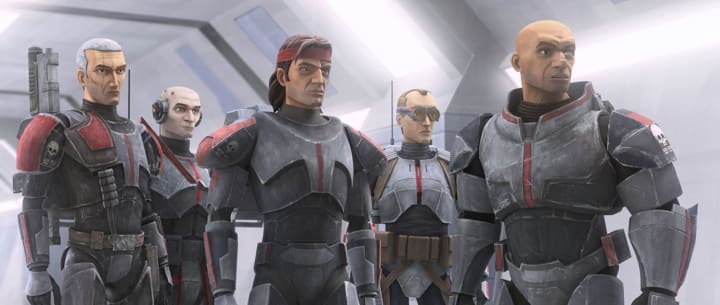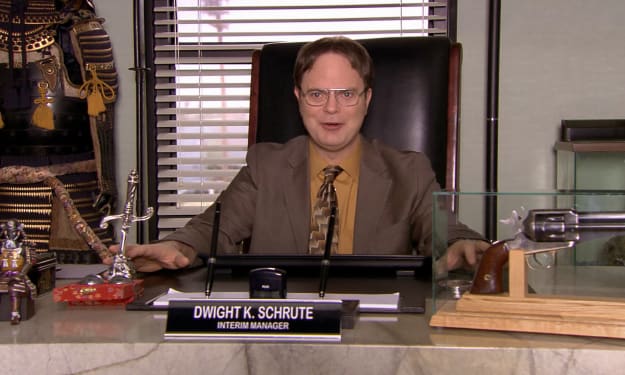How Star Wars Is Retroactively Making The Sequel Trilogy Good
The franchise's game plan to redeem bad writing

The Star Wars franchise has been one of the most successful and influential franchises in the history of cinema. However, the sequel trilogy that was released from 2015 to 2019 has been a controversial topic, because while they were commercially successful, they received universal mixed reviews from fans and critics alike. To fix this, the Star Wars franchise has been trying to make the sequel trilogy more relevant and appealing to fans through its TV shows, such as The Mandalorian, The Bad Batch, and future television shows.
*** Spoilers for Mandalorian Season 3 and Bad Batch Season 2 will appear
The Problem With The Sequel Trilogy

One of the main criticisms of the sequel trilogy was its lack of cohesion and direction. The three movies, The Force Awakens, The Last Jedi, and The Rise of Skywalker were directed by two different directors, J.J. Abrams for episode 7 and 9, and Rian Johnson for episode 8. This led to a disjointed narrative that left many plot holes and fans dissatisfied. To address these issues, the Star Wars franchise has turned to TV shows to fill in the gaps and provide a more coherent story in order to remedy the Sequel Trilogy’s checkered debuts.
Proof Of Concept
Before the sequel trilogy was ever even a thought in people’s mind, the movies in the prequel trilogy were considered to be the worst Star Wars movies in the franchise by fans and critics alike. The criticism was very similar to the sequel trilogy as it introduced questionable plot holes and lacked depth for characters that fans wanted to see more of. Eventually, the Star Wars franchise manage to fix the prequel trilogy’s plot holes through its TV shows to make the movies more relevant and appealing to fans.
The Clone Wars, Tales Of The Jedi, & The Prequel Trilogy
The most notable example of this is the 2008 animated series, Star Wars: The Clone Wars. The show was set between the events of Attack of the Clones and Revenge of the Sith and explored the characters and events of the Clone Wars.
The Clone Wars was initially met with mixed reviews in its early seasons, but over time, it became a critical and commercial success, spanning seven seasons and a movie. Its success was largely part of its expansion of the Star Wars universe as it provided more depth to the events of the prequel trilogy and provided more detailed character development to legacy characters like Obi-wan Kenobi and Anakin Skywalker.

The show also introduced new characters to the franchise such as Ahsoka Tano, Captain Rex, and the Mandalorian warrior, Bo-Katan Kryze all of whom became fan favorites and their stories expanded to other television series. On top of all that, it also reintroduced one-off characters from the prequel trilogy such as Darth Maul, General Grievous, and Count Dooku and expanded their stories.
In addition to what The Clone Wars has done, the 2022 anthology series, Tales of the Jedi is universally praised for its story telling and exploration of the backstory of fan favorite characters, Count Dooku and Ahsoka Tano. The series expands on their presence in the prequel trilogy with Dooku’s inevitable fall of becoming a Sith lord to Ahsoka’s journey on surviving the events of the prequel trilogy.

Star Wars: The Clone Wars was successful in retroactively making the prequel trilogy more relevant and appealing to fans and Tales of the Jedi was the cherry on top that gave fans what they wanted. Both series provided more context and depth to the events and characters of the prequel trilogy allowing the audience to connect more to it.
In addition, both series also expanded the Star Wars universe by introducing new planets, species, and organizations, giving the franchise enough creative space and freedom to create new independent stories. These series essentially laid the groundwork for future Star Wars TV shows and showcased how it can connect themselves to the movies and fix any problems should it arise.
Mando Awakens
In the wake of the sequel trilogy’s criticism came one of the most successful TV shows in the Star Wars franchise, The Mandalorian. The show is set after the events of Return of the Jedi and follows the adventures of a lone bounty hunter, Din Djarin, as he navigates the lawless outer reaches of the galaxy. While the show has its own self-contained storyline, every season has been foreshadowing references to the sequel trilogy in order to replicate the effect of The Clone Wars.

At one point, all three seasons have been laying the groundwork at explaining Supreme Leader Snoke’s origins and Palpatine’s eventual return in the Rise of Skywalker. It is an extremely subtle nod and it comes in the form of Baby Yoda’s genetic DNA, Dr. Pershing’s specialty in genetic engineering, and the remnant factions of the Empire.
In addition, the second and third season have been hinting and exploring how the political landscape has shifted after the events of the Return of the Jedi and showcases a time where the New Republic has become busy with bureaucracy instead of fully hunting down the last extremist remnants of the Empire. With this setup combined with the reveal the Imperial Shadow Council, which was revealed in the final episodes of the third season, this could ultimately lead to the creation of the First Order that was introduced in The Force Awakens.

As the stories in The Mandalorian slowly unfolds, the series will arguably bridge the gap between the original trilogy and the sequel trilogy with these subtle details. While everyone is so focused on the stories of new characters such as Din Djarin and Grogu and the continuation of legacy character stories like Ahsoka Tano and Bo-Katan Kryze, this possible big reveal will surely surprise even the most casual Star Wars fan.
The Last Bad Batch
Another TV show that has been hinting answers that were absent in the sequel trilogy is Star Wars: The Bad Batch, which premiered on Disney+ in 2021. The show is a spin-off of the animated series, The Clone Wars, and follows a group of clone troopers with genetic mutations that give them unique abilities. The show explores the immediate aftermath of the Clone Wars, Order 66, and the rise of the Empire.

Granted the events of The Bad Batch is set before The Mandalorian, but it has been successful in exploring a new story that fills in the plot holes left by the sequel trilogy and the original trilogy. Specifically how the Empire replaced its army of Clone troopers with Stormtroopers and the clone army’s fate as they are secretly being experimented on by a secret splinter group of the Empire. In addition, the show also explores the inner workings of the Empire and the challenges faced by the Rebellion, both of which are central to understanding the backstory and lore of the original trilogy and the sequel trilogy.
The Rise Of Ahsoka?
The Star Wars franchise has also announced several upcoming TV shows that are set to expand the universe even further. One of these shows is Ahsoka, which will follow the adventures of Ahsoka Tano in a post-Empire world. The show is expected to explore the character’s backstory and her role in the rebellion against the Empire and it could build up to some of the events in The Force Awakens.

While Ahsoka’s role in her own spin-off series is nothing but speculation at the moment, but considering how the latest trailer showcases the continuation of her story in Star Wars Rebels, it would be a fair assumption that the Ahsoka series would pitch its own two cents in filling in the cracks of the sequel trilogy even further by providing more context and depth similarly to how The Clone Wars did for the prequel trilogy.
Is It Working Or Is It Too Late?
Only time would tell if this strategy of filling in the cracks would benefit the franchise as the whole, however the Star Wars franchise continues to grow in popularity over time and its relevancy in the past few decades only makes it more relevant and appealing to both old and new fans alike

By exploring the backstory of characters from the sequel trilogy and filling in the gaps in the timeline, the TV shows are providing a more coherent and satisfying narrative. Ultimately, the Star Wars franchise is using its TV shows as a way to keep the franchise fresh and exciting, while also paying homage to its rich history and adding on to its ever expanding lore.
About the Creator
Jay Kobayashi
A starving writer from LA who aspires to be plagiarized one day. I like to write about academic pieces that identifies philosophy and psychology in pop culture, and sometimes random fun pieces that interests me or the algorithm!






Comments
There are no comments for this story
Be the first to respond and start the conversation.